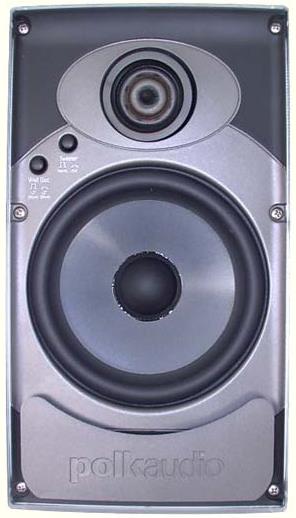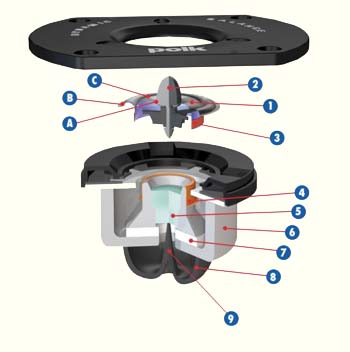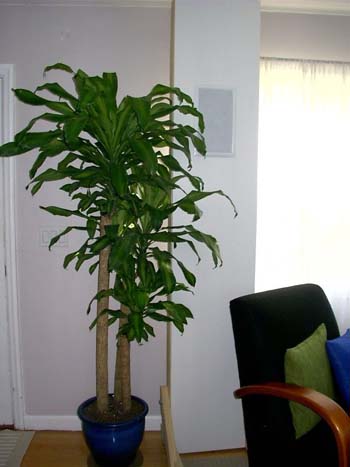|
|
 |
|
Specifications:
● One 1" Ring Tweeter, One 6.5" Woofer
● MFR: 45 Hz - 26 kHz - 3 dB
● Sensitivity: 90 dB
● Recommended Power: 10-125 Watts
● Nominal Impedance: 4 Ohms
● Dimensions: 14.4" H x 8.5" W x 2.5" D
● Shipping Weight: 11 Pounds
● MSRP: $799.99/Pair USA
Polk Audio
www.polkaudio.com
|
|
Introduction
I think that we are all skeptics by nature, and I'm no exception. However,
having a passion for a hobby (I'm sure some would argue a lifestyle more
than a hobby), it would behoove us to be open minded to innovations and
improvements and to blur those preconceptions. That is the position I took
when I considered reviewing in-wall speakers for a complete surround sound
setup.
Manufacturers tell us that one of the hottest markets these
days is custom install, with in-wall and in-ceiling speakers. Consumers really love the idea of having zero
footprints in their home theater speakers. So, speaker companies are adding
in-wall and in-ceiling products, and putting the high performance
technology from their conventional speakers (with enclosures) into the designs.
Polk's new LCi series fits that description.
In the new housing market that has boomed for the last few years, more and
more people have the opportunity to plan their own homes, either from
scratch or through substantial remodeling. With some form of home theater
now becoming an integral part of our lifestyles, A/V planning is no longer an afterthought
relegated to the security/phone guy or the electrician. Thinking also beyond
just home-theater, families are looking for total house sound options from
kitchen and bedrooms to bathrooms and home offices.
Additionally, more homeowners are consulting interior designers and
decorators, and with few exceptions, most would prefer to see their
mid-century American antiqued living rooms sans robust gunmetal gray, or
lacquered monolith speakers dominating the interior scenery. After all, this doesn't quite
photograph well for next months Architectural Digest layout.
 In-wall
or recessed ceiling speakers have in the past fit the bill, leaving a
customized look while leaving the sound solutions stealthy. In fact, it's
not unusual to see multiple pairs of ceiling and in-wall speakers
installed in the average 2,500 sq. ft. home nowadays. In-wall
or recessed ceiling speakers have in the past fit the bill, leaving a
customized look while leaving the sound solutions stealthy. In fact, it's
not unusual to see multiple pairs of ceiling and in-wall speakers
installed in the average 2,500 sq. ft. home nowadays.
Predicting performance is one of the main reason audiophiles resist
in-walls; the enclosure of studs and insulation, exterior sheathing and
siding, the sheet rock wall, things near the speaker on the wall such as paintings
or other wall hangings, all have a dramatic effect on the end result, and we
don't really know how it will sound until the holes are cut and the speakers
are installed. If you don't like it, you have a big hole to patch up.
Polk Audio has been around a long time, and a history of the company is
probably unnecessary. But, if by the time you finish this review and you want
to consider buying in-walls, take a look at their very extensive
website.
Stepping back, if you haven't asked yourself already, how is it possible to
review in-wall speakers without tearing up your walls (in my case circa
1952 plaster walls)? After all, this is not a DIY article for installing
speakers. It's a review of a product that I will be returning to the
manufacturer after the review. The answer is to simply build temporary walls for the speakers. Ok, that requires
some explanation too.
Here is where the spousal approval factor works into my review. Upon
agreeing to receive temporary walls from Paul DiComo, Marketing Director for
Polk Audio, the shipment, and I do mean shipment arrived on a double-wide
palette, and with the help of “Wille O” the delivery guy (yes that's really
his name), we managed to fill my garage with five freestanding monoliths, some
8 feet tall. I knew immediately my wife would have an issue with this one,
enough said.
 The
Design The
Design
Although I did not actually do the installation, the speaker is solidly
built and attaches to the wall firmly. Without the grille, the LC65i is
actually a very attractive design. The grille
has a white felt backing obscuring the image coming through of the drivers
behind. And for those decorators out there, the screen can also be painted
to camouflage it further.
There is a tremendous amount of engineering that went into the design of the
LC65i speaker priced at just under $800/pair, originally designed for
their LSi loudspeakers (these have conventional enclosures). Firstly, this is a two-way design. The Mid/Base
driver is a 6 1/2” aerated polypropylene cone with rubber suspension.
“Aerated” or “foamed” with air, the driver is lighter “suppressing cone
resonance without adding mass” as Polk writes, referring to it as Dynamic
Balance technology. The intent is for clean reproduction with low
distortion.
The
LC65i is designed with a patented “Power Port”, and are the only available
vented in-walls on the market. As the driver moves air
rapidly, Polk Audio argues turbulence created will result in a 3 dB loss in
bass. Through use of a “cone” design located behind the front baffle, proper
airflow increases bass efficiency.
 The
1” Ring Radiator tweeter used in the LC65i may be adjusted and angled up to
15 degrees thereby aiming the high frequencies towards the sitting area of
the room. The
1” Ring Radiator tweeter used in the LC65i may be adjusted and angled up to
15 degrees thereby aiming the high frequencies towards the sitting area of
the room.
With a 90 dB efficiency, this 4 Ohm speaker's frequency response is between
30 Hz - 27 kHz, and weighs about 8 pounds.
There are two adjustments on the speaker. As the placement of in-walls may
also not be in a prime location, the LC65i has a toggle feature if it's
placed closer than 2 ft to a perpendicular wall. With a potential bump
between 50 Hz and 200 Hz, the crossover adjusts to remove any anticipated boominess. The second toggle is a Tweeter Attenuation; the concern is that
the speaker is placed within proximity of another reflective surface causing
a “brighter” sound and image distortion. By setting the toggle switch to
“Low” a band-pass filter removes the potential of the reflective surface
using, leaving detailed clearer sound.
Polk Audio has also designed an optional
“performance enclosure” for their LCi in-wall speakers meant to house the speaker in a conventional stud
framed wall. Designed to fit between typical stud wall framing at 16” on
center, the enclosure measures 14” wide x 55” tall and 3 ½” deep. Unable to
accurately predict the performance of their speakers, especially from a bass
standpoint, Polk decided to help the homeowner by engineering the “perfect
audio cabinet for bass performance”. Constructed of MDF (used extensively in
loudspeaker construction), the enclosure ensures the best possible
performance from the speaker. The enclosure is not a requirement as there
are other methods of creating “cabinets” recessed into your wall.
 An
in-wall subwoofer was not included in this review, as Polk does not have an
in-wall subwoofer yet, but I imagine they are on the way. An
in-wall subwoofer was not included in this review, as Polk does not have an
in-wall subwoofer yet, but I imagine they are on the way.
Setup
I arranged the 8' frames around my 12' x 16' x 8' living room, a la
Stonehenge. I attempted to keep the units as
close to the walls in the room as possible, simulating a true in-wall setup.
I aligned the tweeters, and I also made adjustments with the toggle settings
previously described. Using a 100WPC receiver, I was set to go.
Listening
As curious as I was to evaluate
two-channel music, for the purposes of this
review I limited my listening to multi-channel audio and DVDs. I can tell
you I did spend much time listening to CDs, and I was not disappointed, but
my intention from the beginning was to consider the idea of an
in-wall surround sound configuration.
My preconceptions were such that I expecting a thinness to the sound, but to
my surprise, it was quite the opposite, my first revelation. My immediate
impression was how airy the sound was, spatial and full. It was not extremely
large, but I was pleasantly surprised that these speakers filled the room.
Although not deep, bass was adequate. Here, as in any speaker system, a
subwoofer would take care of the lowest octave easily. Polk has conventional
subs for this purpose.
 I
especially liked the LC65i for a center channel, it surprised me in fact,
how intelligible and perfectly natural voices sounded. Usually I'm straining
to hear detail from the center channel at lower volume levels (in
consideration of other people at home). Not so with the Polk, the unit was excellent
at low volume. I
especially liked the LC65i for a center channel, it surprised me in fact,
how intelligible and perfectly natural voices sounded. Usually I'm straining
to hear detail from the center channel at lower volume levels (in
consideration of other people at home). Not so with the Polk, the unit was excellent
at low volume.
At
higher volumes, the LCi was especially crisp. Although a subtle coarseness
became evident at extreme volumes, I couldn't imagine anyone listening at
such levels. I found music and movie sound reproduction tight and accurate.
Movie soundtracks nicely surrounded the display.
Although the system needs a subwoofer, the LCis really shine in the
midrange. They have clean rich
tones, and a wonderful layering of instruments and sounds. Moving around the
room, I noticed very little directional differences (off-axis)
The
review units had Performance Enclosures, because they were mounted on a
sheet rock frame. They would not have performed well, obviously, if they were
not enclosed, since the frames were not actually part of my room walls. So,
I don't know how they would have performed without enclosures, and simply
mounted between studs in a wall, using the space between the studs as their
"enclosure". I suspect there would have been a bit more bass, as the
enclosure space would have been larger. The fact that bass was adequate even
with the built-in enclosures is revealing.
When I wanted to let Paul know of my satisfaction with what I was hearing, I
e-mailed him and his response was a confident, “I knew you would”.
Conclusions
Prepare yourself, because the in-wall revolution is upon us, whether you're looking
for wall mounted units for your plasma screen, or further going the route of
completely recessing your entire set of surround sound speakers. Don't believe me? Go to any Hi-Fi show,
and you will see that all the major
manufacturers are designing and producing these units. This is not
merely an “Me too” attitude. When I approached one about the market, he
said, “It's huge”.
As an architect, I'd be the first to appreciate the clean look of flush
mounted speakers, painted to match their surroundings. The next time a home
owner suggests in-wall speakers for a project, I won't wince as I usually
might. Polk Audio made that happen. As I plan my own home theater/family
room, I'd like to give in-walls some consideration. Polk has forced me to
take seriously in-wall designs as true high performance speakers.
- Piero Gabucci -
Terms and Conditions of Use

|


 In-wall
or recessed ceiling speakers have in the past fit the bill, leaving a
customized look while leaving the sound solutions stealthy. In fact, it's
not unusual to see multiple pairs of ceiling and in-wall speakers
installed in the average 2,500 sq. ft. home nowadays.
In-wall
or recessed ceiling speakers have in the past fit the bill, leaving a
customized look while leaving the sound solutions stealthy. In fact, it's
not unusual to see multiple pairs of ceiling and in-wall speakers
installed in the average 2,500 sq. ft. home nowadays.  The
Design
The
Design The
1” Ring Radiator tweeter used in the LC65i may be adjusted and angled up to
15 degrees thereby aiming the high frequencies towards the sitting area of
the room.
The
1” Ring Radiator tweeter used in the LC65i may be adjusted and angled up to
15 degrees thereby aiming the high frequencies towards the sitting area of
the room.  An
in-wall subwoofer was not included in this review, as Polk does not have an
in-wall subwoofer yet, but I imagine they are on the way.
An
in-wall subwoofer was not included in this review, as Polk does not have an
in-wall subwoofer yet, but I imagine they are on the way. I
especially liked the LC65i for a center channel, it surprised me in fact,
how intelligible and perfectly natural voices sounded. Usually I'm straining
to hear detail from the center channel at lower volume levels (in
consideration of other people at home). Not so with the Polk, the unit was excellent
at low volume.
I
especially liked the LC65i for a center channel, it surprised me in fact,
how intelligible and perfectly natural voices sounded. Usually I'm straining
to hear detail from the center channel at lower volume levels (in
consideration of other people at home). Not so with the Polk, the unit was excellent
at low volume.

